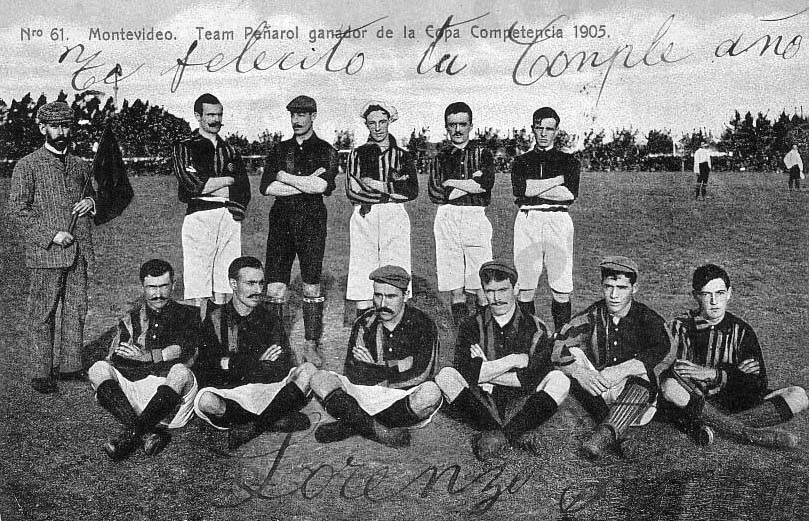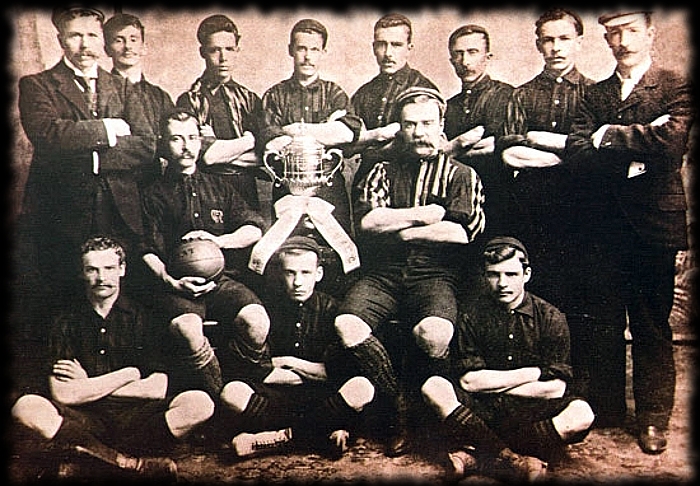|
Estadio José Pedro Damiani
Estadio Contador Damiani, formerly Las Acacias, is a stadium in Montevideo, Uruguay, inaugurated in 1916 and re-built in 1997. It is used mostly for Peñarol's reserves matches.El centenario de Las Acacias at ''El País'' The stadium, mostly used for football matches, can hold up to 7,000 people.Peñarol: Las Acacias se moderniza con césped artificial y un aforo de 7000 personas at Fútbol.uy |
Peñarol
Club Atlético Peñarol (; English: ''Peñarol Athletic Club'') —also known as ''Carboneros'', ''Aurinegros,'' and (familiarly) ''Manyas''— is a Uruguayan sports club from Montevideo. The name "Peñarol" comes from the Peñarol neighbourhood on the outskirts of Montevideo. Throughout its history the club has also participated in other sports, such as basketball and cycling. Its focus has always been on football, a sport in which the club excels, having never been relegated from the top division. In international competition, Peñarol is the third-highest Copa Libertadores winner with five victories and shares the record for Intercontinental Cup victories with three. In September 2009, the club was chosen as the South American Club of the Century by the IFFHS . Apart from men's football, other active sports sections of Peñarol are rugby union, futsal, women's football, and athletics. History Origins On September 28, 1891, employees of the Central Uruguay Railwa ... [...More Info...] [...Related Items...] OR: [Wikipedia] [Google] [Baidu] |
Central Uruguay Railway Cricket Club
Central Uruguay Railway Cricket Club (mostly known for its acronym CURCC) was a Uruguayan sports club, originally established by British railway workers for the practise of cricket. Nevertheless, the club would be notable for its football section, considered one of the greatest contributors to that sport in Uruguay. In fact, CURCC was one of founding members of Uruguayan Football Association (AUF) in 1900.Historia de la Asociación on AUF website The continuity between the CURCC's football section and club generated a controversy that remains nowadays."C.U.R.C.C. versus Club A. Patria", chronicle on ''La Razón'', 23 Jul 1914 (page 6) History Railway ...
|
Sports Venues Completed In 1916
Sport pertains to any form of competitive physical activity or game that aims to use, maintain, or improve physical ability and skills while providing enjoyment to participants and, in some cases, entertainment to spectators. Sports can, through casual or organized participation, improve participants' physical health. Hundreds of sports exist, from those between single contestants, through to those with hundreds of simultaneous participants, either in teams or competing as individuals. In certain sports such as racing, many contestants may compete, simultaneously or consecutively, with one winner; in others, the contest (a ''match'') is between two sides, each attempting to exceed the other. Some sports allow a "tie" or "draw", in which there is no single winner; others provide tie-breaking methods to ensure one winner and one loser. A number of contests may be arranged in a tournament producing a champion. Many sports leagues make an annual champion by arranging games in a r ... [...More Info...] [...Related Items...] OR: [Wikipedia] [Google] [Baidu] |
Artificial Turf
Artificial turf is a surface of synthetic fibers made to look like natural grass. It is most often used in arenas for sports that were originally or are normally played on grass. However, it is now being used on residential lawns and commercial applications as well. The main reason is maintenanceartificial turf stands up to heavy use, such as in sports, and requires no irrigation or trimming. Domed, covered, and partially covered stadiums may require artificial turf because of the difficulty of getting grass enough sunlight to stay healthy. Artificial turf does have its downside, however: limited life, periodic cleaning requirements, petroleum use, toxic chemicals from infill, and heightened health and safety concerns. Artificial turf first gained substantial attention in 1966, when it was installed in the year-old Astrodome. The specific product used was "ChemGrass", developed by Monsanto and rebranded as AstroTurf; this term since then became a generic trademark for any ... [...More Info...] [...Related Items...] OR: [Wikipedia] [Google] [Baidu] |
Estadio Campeón Del Siglo
Estadio Campeón del Siglo is a football stadium located in Bañados de Carrasco, Montevideo, Uruguay, and the home ground of Peñarol, who plays in the First Division. It has a maximum capacity of 40,000. History Background Projects to own a stadium date back to the 20th century, but never managed to materialize. Although the club already owned the Estadio Contador Damiani (former Las Acacias) since 1916, it is currently not approved for Uruguayan Primera División matches by authorities, due to lack of security, and it is used by the club's youth divisions instead. The first project dates back to 1933, when the team presented a project to build a stadium near Montevideo's promenade, same place in which now the popular Teatro de Verano is found. Half a century later, in 1998, the club announced plans, presenting a real life model, of a stadium to be built in the Franklin D. Roosevelt park near Avenida Gianattassio, in Canelones. On the successive years, under the comman ... [...More Info...] [...Related Items...] OR: [Wikipedia] [Google] [Baidu] |
Estadio Centenario
Estadio Centenario is a stadium in the Parque Batlle of Montevideo, Uruguay, used primarily for football. The stadium was built between 1929 and 1930 to host the inaugural 1930 FIFA World Cup, as well as to commemorate the centenary of Uruguay's first constitution. It is listed by FIFA as one of the football world's classic stadiums. On July 18, 1983, it was declared by FIFA as the first Historical Monument of World Football, to this day the only building to achieve this recognition worldwide.The mythical Centenario stadium, a "Historical Monument of Football", welcomes the finals of the U-20 Sudamericano Tournament , January 25, 2015 ... [...More Info...] [...Related Items...] OR: [Wikipedia] [Google] [Baidu] |
Rampla Juniors
Rampla Juniors Fútbol Club, commonly known as Rampla Juniors, is a Uruguayan football club based in Montevideo. The team was actively playing the 2021 season by January 2021. In their home stadium, Rampla won the Uruguayan championship in 1927. In 2019, the Rampla Juniors Fútbol Club had Estadio Olímpico, with 6,000 capacity, as its home stadium. Fans are nicknamed "The Flinstones," as they helped build the team's home stadium in the 1960s, which resembled a quarry. History Origin and colours Rampla Juniors were founded in the Aduana area (also the birthplace of River Plate FC), then moved first to the Aguada neighborhood, and finally, around 1920, to the Cerro neighborhood. Their colors are taken from Fortaleza, a club that existed in the early years of Rampla's stint in the Cerro area. Another story of how they chose their colors is similar to how Boca Juniors supposedly got the idea for their kit colors from a Swedish flag on a ship. It is rumored that Rampla's founder ... [...More Info...] [...Related Items...] OR: [Wikipedia] [Google] [Baidu] |
Uruguayan Primera División
The Liga Profesional de Primera División (American Spanish , en, First Division Professional League, local: , ''First Division''), named "Torneo Uruguayo Copa Coca-Cola" for sponsorship reasons, is the highest professional Association football, football league in Uruguay and organized by the Uruguayan Football Association (AUF). The first championship was held in 1900 Uruguayan Primera División season, 1900, being an amateur competition until 1932 Uruguayan Primera División, 1932 when the league became professional. From 1900 to the 2014–15 season there have been 111 first division seasons. In 2011, the Uruguayan Primera División was regarded as the 23rd most difficult football league in the 21st century by the International Federation of Football History & Statistics (IFFHS). If considered the same club, Peñarol/Central Uruguay Railway Cricket Club, CURCC is the most successful Uruguayan club with 51 titles. Otherwise, it is Club Nacional de Football, Nacional with 49 ti ... [...More Info...] [...Related Items...] OR: [Wikipedia] [Google] [Baidu] |
Club Nacional De Football
Club Nacional de Football (, ''National Football Club'' or simply as Nacional) is a Uruguayan professional sports club based in Montevideo. The club was founded on 14 May 1899 as a result of the merger between ''Uruguay Athletic Club'' and ''Montevideo Fútbol Club''. Although its main focus is football, the club hosts many other activities, including basketball, futsal, tennis, cycling, volleyball, and chess. In domestic tournaments, Nacional has won the Primera División title 49 times, most recently in the 2020 season. Domestic cups honors include Copa de Competencia (8 times) and Copa de Honor (7 times), among others. At international level, Nacional has won 22 titles recognised by FIFA and CONMEBOL, including three Copa Libertadores. In this tournament, Nacional is the 2nd best club all-time with 618 points. Nacional has also won all three Copa Intercontinental it has competed in, becoming the second three time world champion in 1988. In addition, Nacional is the only ... [...More Info...] [...Related Items...] OR: [Wikipedia] [Google] [Baidu] |
Uruguayan Peso
Uruguayan peso ( es, peso uruguayo) has been a name of the Uruguayan currency since Uruguay's settlement by Europeans. The present currency, the ''peso uruguayo'' (ISO 4217 code: ) was adopted in 1993 and is subdivided into 100 '' centésimos'', although centésimos are not currently in use. Introduction Uruguay obtained monetary stability in 1896, based on the gold standard. This favorable state of affairs ended after World War I. An unsettled period followed. Economic difficulties after World War II produced inflation, which became serious after 1964 and continued into the 1970s. The peso moneda nacional was replaced on 1 July 1975 by the nuevo peso (new peso; ISO 4217 code ) at a rate of 1 new peso for 1000 old pesos. The nuevo peso was also subdivided into 100 ''centésimos''. After further inflation, the peso uruguayo (ISO 4217 code ) replaced the on March 1, 1993, again at a rate of 1 new for 1000 old. Inflation Uruguayans became accustomed to the constant devaluation ... [...More Info...] [...Related Items...] OR: [Wikipedia] [Google] [Baidu] |
José Pedro Damiani
José Pedro Damiani (October 10, 1921 – August 25, 2007) was an Uruguayan politician and accountant. He was the Uruguay Uruguay (; ), officially the Oriental Republic of Uruguay ( es, República Oriental del Uruguay), is a country in South America. It shares borders with Argentina to its west and southwest and Brazil to its north and northeast; while bordering ...an president of the "Club Atlético Peñarol". 1921 births 2007 deaths People from Montevideo University of the Republic (Uruguay) alumni Uruguayan accountants Colorado Party (Uruguay) politicians Uruguayan football chairmen and investors Burials at Cementerio del Buceo, Montevideo {{Uruguay-politician-stub ... [...More Info...] [...Related Items...] OR: [Wikipedia] [Google] [Baidu] |
Poaceae
Poaceae () or Gramineae () is a large and nearly ubiquitous family of monocotyledonous flowering plants commonly known as grasses. It includes the cereal grasses, bamboos and the grasses of natural grassland and species cultivated in lawns and pasture. The latter are commonly referred to collectively as grass. With around 780 genera and around 12,000 species, the Poaceae is the fifth-largest plant family, following the Asteraceae, Orchidaceae, Fabaceae and Rubiaceae. The Poaceae are the most economically important plant family, providing staple foods from domesticated cereal crops such as maize, wheat, rice, barley, and millet as well as feed for meat-producing animals. They provide, through direct human consumption, just over one-half (51%) of all dietary energy; rice provides 20%, wheat supplies 20%, maize (corn) 5.5%, and other grains 6%. Some members of the Poaceae are used as building materials (bamboo, thatch, and straw); others can provide a source of biofuel, ... [...More Info...] [...Related Items...] OR: [Wikipedia] [Google] [Baidu] |



.jpg)


